The DS-1 Orbital Battle Station, or mk. 1 deep-space mobile battlestation better known as the Death Star or Death Star I, and known to the public as the Imperial Planetary Ore Extractor, was a massive Imperial battlestation and superweapon with a diameter of 160 kilometers designed to enforce law and order throughout the Empire with the threat of planetary destruction. It started off as the Separatist Ultimate Weapon before becoming the Expeditionary Battle Planetoid Development Initiative or Project Death Star after it ceased to be a Separatist project and became an Imperial one in 19 BBY.
It's design origins lay in the Raith Sienar's Expeditionary Battle Planetoid. Sienar, who had become disillusioned about the project due to its impracticalities, nonetheless shared the design with Wilhuff Tarkin in 29 BBY. Tarkin, claiming the design as his own, shared Sienar's ideas with Supreme Chancellor Palpatine. Palpatine ordered Bevel Lemelisk and Tol Sivron to work with Poggle the Lesser's Geonosian hives on the design. During the First Battle of Geonosis, Palpatine's secret apprentice, Dooku, brought the improved design back to Palpatine.
Around 19 BBY, near the end of the Clone Wars, construction of the first Death Star had begun at occupied Geonosis, and construction continued after the rise of the Galactic Empire. Under the Empire, the projects headquarters moved mulitple times from Geonosis to Seswenna and then to the Patriim system. In 3 BBY, the project was moved to its final location, the Horuz system.
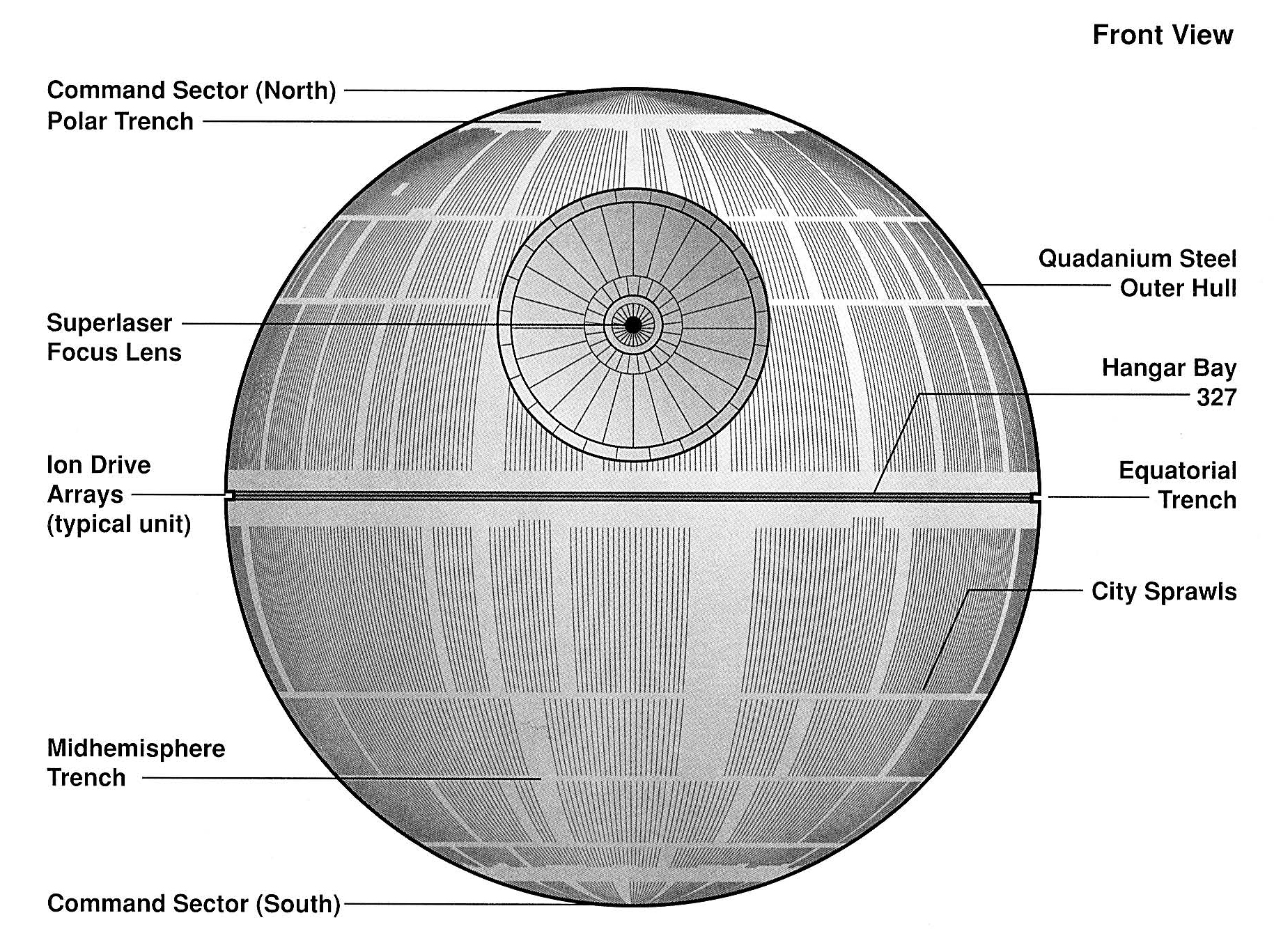
Schematics of the first Death Star
The DS-1 Orbital Battle Station, or mk. 1 deep-space mobile battlestation better known as the Death Star or Death Star I, and known to the public as the Imperial Planetary Ore Extractor, was a massive battlstation built for planetary destruction. The basic structure of the station was a sphere the size of a Class-IV moon, with a kilometer-wide trench containing docking bays running around its equator. It was the very incarnation of the Tarkin Doctrine. Because of its size and shape, it was sometimes mistaken for a small moon.
The first Death Star, like its successor, was divided into two hemispheres, each subdivided into 12 bridge-controlled zones, for a total of twenty four zones also known as sprawls or sectors. Each sprawl would have , hangar bays, hydroponics, detention blocks, medical centers, armories, command centers, and every other facility needed to provide service for any mission deemed necessary. In an emergency, auxiliary command centers located in each sprawl provided full weapons and maneuverability control, for a redundancy depth of twice a dozen. Each zone had its own brige, and each zone bridge reported to the Death Star's overbridge, located just above the superlaser. The Death Star comprised eighty-four separate internal levels, which where 1,148 meters (4,685 feet) in height. Each level had 357 4 meter (13.1 foot) high sublevels. A nominal number of sub-levels were then to be stacked around the surface of the sphere, encompassing the inner stacked levels. A number of the Death Star's docking bays were reserved as executive docking bays for high-ranking personnel, featuring larger facilities and more significant defenses.
The battlestation had two massive sublight engines in the midsection and a formidable hyperdrive system. Driven by 123 individual generators tied to one navigational matrix, the Class 4 hyperdrive was fast enough to allow the Death Star to travel thousands of light-years from Alderaan to Yavin IV in only a few hours. All engineers working near the highly radioactive engines wore radiation suits to minimize harmful exposure. Grand Moff Wilhuff Tarkin once likened walking inside the Death Star to walking inside the Caves of Corips, but with illuminated tubing and plastisteel replacing the natural surroundings.
Facilities included parks, shops, and other amenities for the Human crew, as well as numerous infrastructure necessities such as trash compactors, like Garbage Compactor 3263827. The hull of the planetoid was covered in quadanium steel.
Near the northern pole, a hundred-meter tower was constructed and shielded to near impenetrability for the Emperor to use as personal quarters while on board. Operational command of the space station took place from the overbridge, which included the conference room. A high-speed shuttle system was reserved for officers to traverse the station quickly.
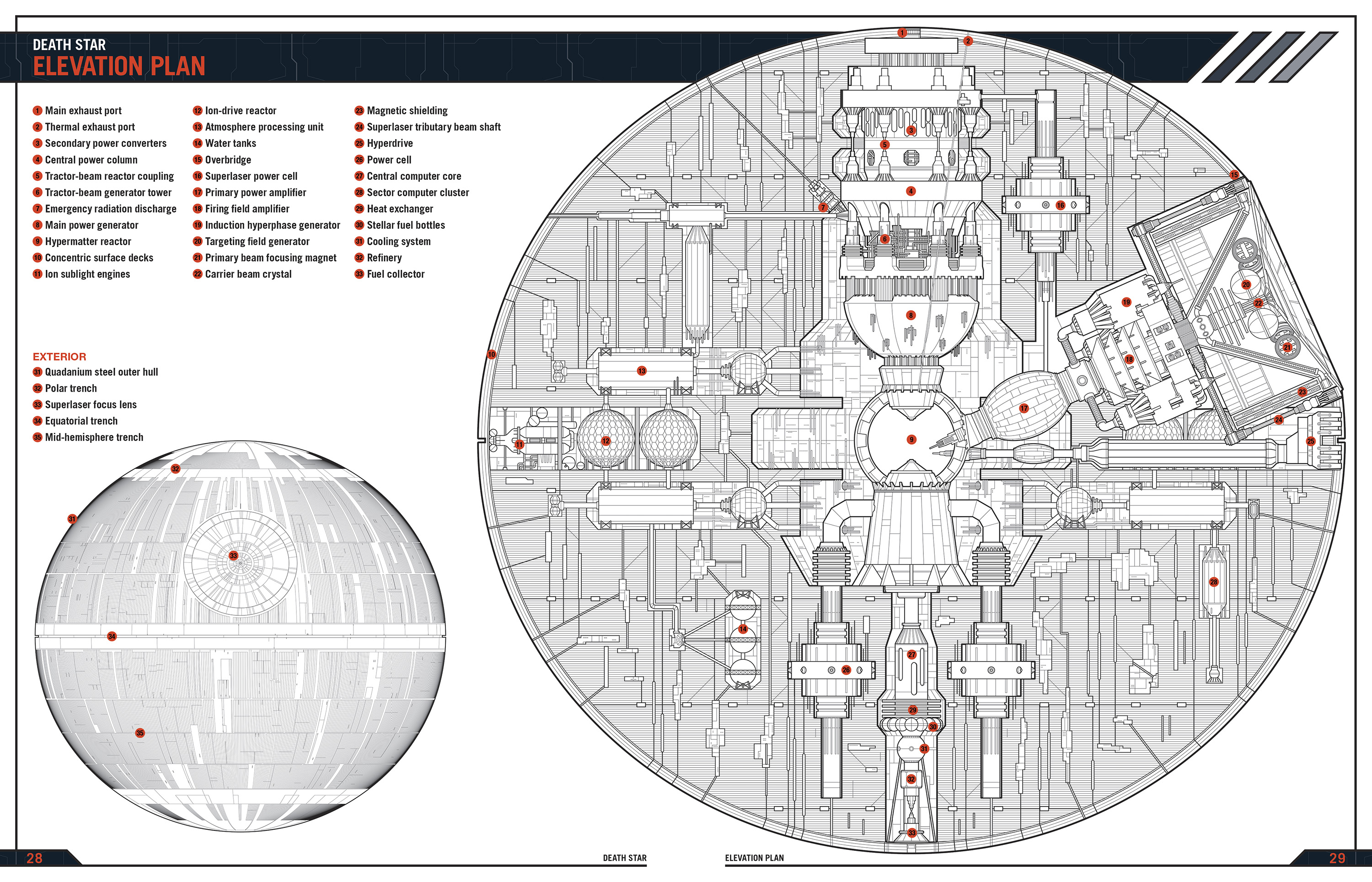
Elevation plans for the first Death Star
The Death Star's design included a small but significant flaw: an exposed thermal exhaust port. At one point in the construction process, this exhaust port was identified as unnecessary. When the architect responsible for the area asked the Wookiee overseeing construction of the area to omit the port, he insisted on getting the amendment to the plans in writing. Before the architect had a chance to submit such an amendment, the Wookiee became ill and was confined to a medcenter, and his replacement built the port as specified in the plans. The port was two meters wide, approximately the size of a womp rat; lay at the end of a large trench in the hull of the battle station; and was ray shielded against energy weapons such as laser cannons.
As impressive as the Death Star's design was, its armament and defensive measures were also extensive. Its primary weapon was its Concave Dish Composite Beam Superlaser, which Bevel Lemelisk had included in the final design. Although Tarkin had initially intended for the Death Star's weapon to "rock a [targeted] world to its very core," the final superlaser design was capable of shattering worlds, leaving behind only asteroid ruins. There were also plans for installing a composite beam superlaser as an alternative due to the challenges of building an operational, single-beam superlaser, which required a mechanical arm to move it into place, although the plans were scrapped when the engineers resolved the technical difficulties of the planet-shattering superlaser.
The entirety of the Death Star's spherical design, including the majority of its interior volume, was dedicated to the support and maintenance of the superlaser. The diameter of the superlaser cannon well was approximately 35 kilometers. The energy for the superweapon originated from deep within the battle station, and was channeled into an array of eight initiator laser cannons. The eight laser cannons, via tributary beams, then converged into a central nexus point above the cannon well to form a powerful single beam. The superlaser likewise required eight superlaser firing stations: four primary stations plus four backups in case one of the stations failed. The superlaser was dangerous even to itself, so various safeguards were implemented to prevent the battlestation from being consumed by its own power, with several being resolved via Project Hammertong. One of these were the tributary beam shafts, with eight lining the circumference of the superlaser weapon. The tributary beam shafts, originally meant for Hammertong, were constructed at Desolation Station. Focusing coils also lined the tributary shafts to maintain the beams' integrity. The tributary beams had to be perfectly calibrated and aligned; otherwise, the central beam would misfocus and dissipate, resulting in a flurry of backscatter that could severely damage or even destroy the superlaser housing. The firing process generated magnetic fields and gravitational flux, necessitating their dissipation to prevent the amplification crystals from becoming misaligned and the battle station from tearing apart.
The northern hemisphere held the main armament of the station, a fearsome superlaser. This weapon had the external appearance of a bowl many kilometers wide. When activated, eight separate beams were each activated by a crystal through the particle accelerator tubes, amplified through rings, and conjoined to form one of eight separate beams that would converge outside the dish, focusing into a point to form a single incredibly powerful superlaser beam. The power settings of the superlaser were adjustable, allowing for the destruction of naval vessels and planets alike. Blasts with the power to destroy naval vessels could be fired roughly once every minute, while planet-destroying blasts could only be fired once per day. This superlaser was powerful enough to destroy even a shielded planet with a single shot.
The superlaser could be set to varying power levels, with one power level sufficient to use against enemy ships. At full power, the superlaser required a standard day (24 hours) to recharge, while usage of the superlaser against spaceborne vessels only required a minute of recharging.
A downside to the presence of the superlaser was that the Death Star had to forgo all but the most rudimentary shielding capabilities in order to achieve such destructive power. However, its surface-to-air defenses were sufficient to make up for its lack of efficient shielding. It possessed 5,000 Taim & Bak XX-9 heavy turbolasers, 2,500 Borstel Galactic Defense MS-1 ion cannons, 2,500 Borstel Galactic Defense SB-920 laser cannons, and 5,000 Taim & Bak D6 turbolaser batteries that acted as its surface-to-air defenses. The SB-920 batteries were largely congregated around the Death Star's trenches, were powerful enough to destroy starfighters with a single shot, and utilized an advanced Target Acquisition and Targeting (TAT) system similar to that of certain Imperial surface-to-air defense systems. The XX-9 heavy turbolasers used on the Death Star were variants that had four sections and were overall larger. To ensure the turrets didn't cause friendly fire and to deter hijackers from attacking their posts, a safety mechanism automatically locked them up when any part of the Death Star was within their sights, making them disadvantageous against starfighters. Besides defense, the turbolaser batteries acted as directional markers for TIE fighter pilots.
Shield-projection towers on the Death Star's surface emitted energy fields that covered the Death Star's city sprawls, protecting them from space debris as well as providing limited defense against energy weapons, due to most of the Death Star's energy reserves being harnessed for the superlaser. At least three shield-projection towers were necessary for a city sprawl, with their power cells, machinery, and shield-operator stations located at the bases of the towers. In addition, they were highly concentrated around the tower containing the Emperor's throne room, for obvious reasons. Shield operation fell under the jurisdiction of Battle Station Operations, with various officers, operators, and technicians tasked with manning the shield-projection towers' stations to ensure that the shields were always in full working order. During battle, the shields of neighboring sprawls could overlap to create a continuous blanket of energy over the surface.
The battlestation also had field generators, which included a jamming field that affected every sensor of enemy ships except sight, and could create distortion potent enough to reduce the maneuverability of starfighters to less than point three, at least along the meridian trench housing the thermal exhaust port.
The Death Star's hull plating was made of military-grade Quadanium steel, most of which had been drawn and processed from asteroidal metal. Because of the challenges of not only creating the material necessary, but also producing enough to install the plating onto the station, several sections of the Death Star were pressurized during the installation of the hull for efficiency purposes, such as storage space for supplies during construction as well as temporary habitats for laborers. The Death Star's hull from a distance appeared relatively smooth to the naked eye.
The Death Star had 768 modified Phylon Q7 tractor beam projectors, of which 24 were assigned for each zone of the Death Star. The projectors in each zone could concentrate one or all of their tractor beams onto a single target from a significant enough distance to ensnare distant enemy ships in a virtually unbreakable energy bubble, and were powerful enough to capture the vessels long before the vessels' sensors could identify it as a battle station instead of a small moon. Each required a crew of ten to operate, and was coupled to the main reactor to prevent accidents caused by generator malfunctions. There were seven power coupling terminals in all, identified atop a 35-kilometer-tall generator tower, and providing energy for more than 700 tractor beams. However, disabling even one of the coupling sites from the main reactor would result in the tractor beam becoming inoperative.
Aside from the outer defenses and armaments on the surface of the station, the inner areas of the station also provided a significant amount of security measures as well, including metallic spikes (which were directly inspired by the stalagmite-filled pits within the various cavern networks on Tatooine), BlasTech Class VI automated laser projectors, which were linked by security cameras, and IT-O interrogator droids, which sometimes acted as defensive systems against intruders.
The Death Star possessed a complement of 11,000 combat vehicles, 7,000 TIE fighters, four strike cruisers and more than 20,000 other military and transport vehicles.
Overall, the Death Star's firepower was had more destructive firepower than half of the Imperial Navy, and was regared as the most powerful force in the galaxy.
Owing to the rigid command structure of various Imperial organizations, the Death Star's command structure, known as command sectors, was just as rigid.
The battle station was under the direct command of Grand Moff Wilhuff Tarkin. Below him was a triumvirate composed of Army Command, Naval Command, and Battle Station Command, represented by High General Cassio Tagge, Admiral Conan Antonio Motti, and General Hurst Romodi, respectively, although when the Galactic Emperor made visits, his authority superseded theirs. Below them were the Operations Chiefs for the Army, Navy and Battle Station Operations, all of whom were held by officers with the rank of colonel. Below each Operations Chief, there were eight majors, each representing specific departments under their branch of operations, alongside four majors tasked with the general, service, technical, security, and military sectors (the last including Army troopers, the Death Star troopers [a subset of the Imperial Navy troopers], gunners, and TIE pilots). Lastly, lieutenants were tasked with supervising the command sectors and were the lowest-ranked officers to do so, relegated to Command sector duty posts.
The only exceptions to the command structure were members of the Stormtrooper Corps, and the Emperor's emissary Lord Darth Vader, the latter of whom answered to Grand Moff Tarkin alone. Members of the Army and Navy portions of the Death Star could call upon the stormtroopers' services if necessary, although with the firm understanding that they fell under neither jurisdiction and were to obey the Emperor alone.
The concept for the Death Star could be found in its precursor, the "Expeditionary Battle Planetoid." Raith Sienar came up with the concept by 29 BBY, around the time of the Second Battle of Zonama Sekot. Sienar made concept designs of the Battle Planetoid: It was an immense space station with a 100 km diamter main sphere and two smaller spheres, the smaller spheres connected to the main sphere by poles. It used massive turbolasers and was powered by an internal plasma implosion core more than a kilometer wide. Unlike its Death Star descendant, it lacked a superlaser, as it was designed for space combat. The design would requie massive advanced in hypermatter technology, and Sienar envisioned the station being powered by ice asteroids.
Raith showed the designs to the commander of the Republic Outland Regions Security Force, Wilhuff Tarkin. Tarkin was interested in the concept, as it allowed to break the "stateless strategy" of warfare. However, by the time Sienar showed the design to Tarkin, Sienar had already lost interest in the design, thinking it impractical due to the technological advances required for its completion. However, Tarkin, who esteemed the design more than Sienar, showed the design to Supreme Chancellor Palpatine, claiming it as his own as part of the Tarkin Doctrine.,
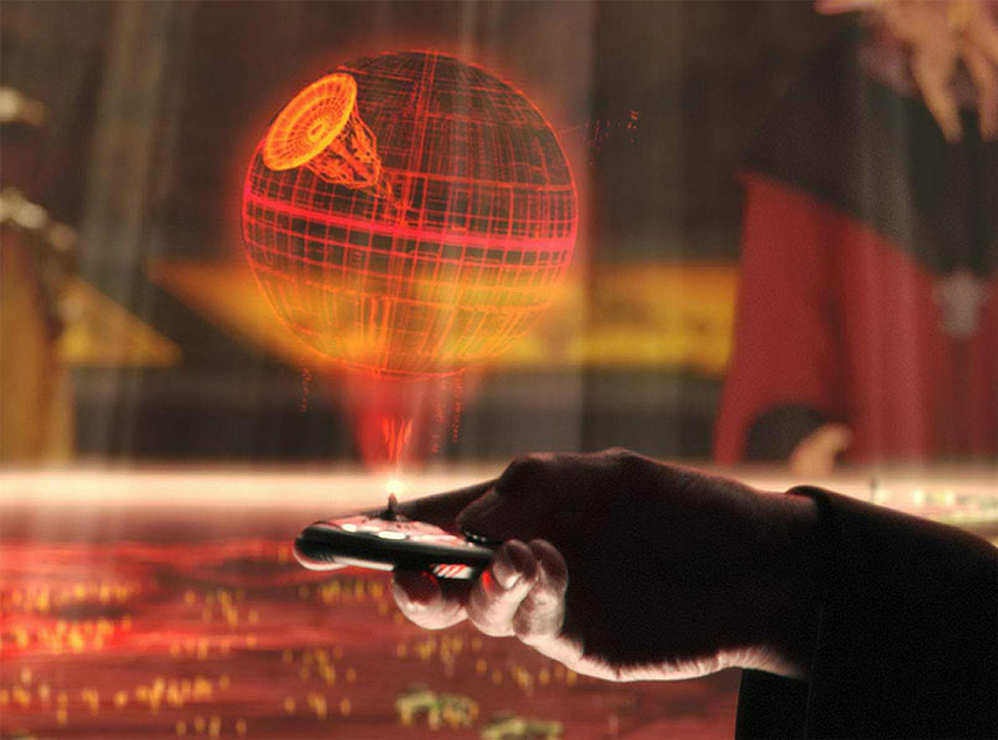
The plans for the Ultimate Weapon given to Count Dooku by Poggle the Lesser during the Battle of Geonosis
Palpatine then ordered Bevel Lemelisk and Tol Sivron to work with Poggle the Lesser and his Geonosian hives to pusue the needed advanced in hypermatter technology, as well as structural concerns. When Geonosis seceded from the Republic, Lemelisk was concered about the project. Palpatine, however, remained oddly unconcerned, and assured Lemelisk that the Separatists would never put the weapon into production.
In 22 BBY, Poggle the Lesser, leader of the Geonosians, returned the top-secret design to Count Dooku to prevent it from falling into the hands of the Jedi during the Battle of Geonosis. Dooku took the designs back to Coruscant and gave them to Darth Sidious, his dark master. These plans would later be fused with Wilhuff Tarkin and Raith Sienar's vision of an Expeditionary Battle Planetoid.
Near the end of the Clone Wars, Sidious ordered Geonosian builders to begin construction on the station over their occupied homeworld. Hundreds of thousands of workers were busy building the station throughout the war. Around five months after the Battle of Geonosis, Dooku briefly considered halting production of the Weapon in favor of the Planet Killer, but changed his mind after the demonstration failed, thanks to sabotage by Mace Windu. 17 months after the start of the war, Geonosian technicians on Zaadja were observed working on the Weapon's design.
In 19 BBY, Supreme Chancellor Palpatine sent the 501st Legion on a mission to Mygeeto where they were to collect an energy sample that would be used in the station's superlaser of the soon to be formed Galactic Empire. During the last few weeks of the war, the Separatist Council debated on ways to prolong the war, to allow their secret weapon time to be finished.
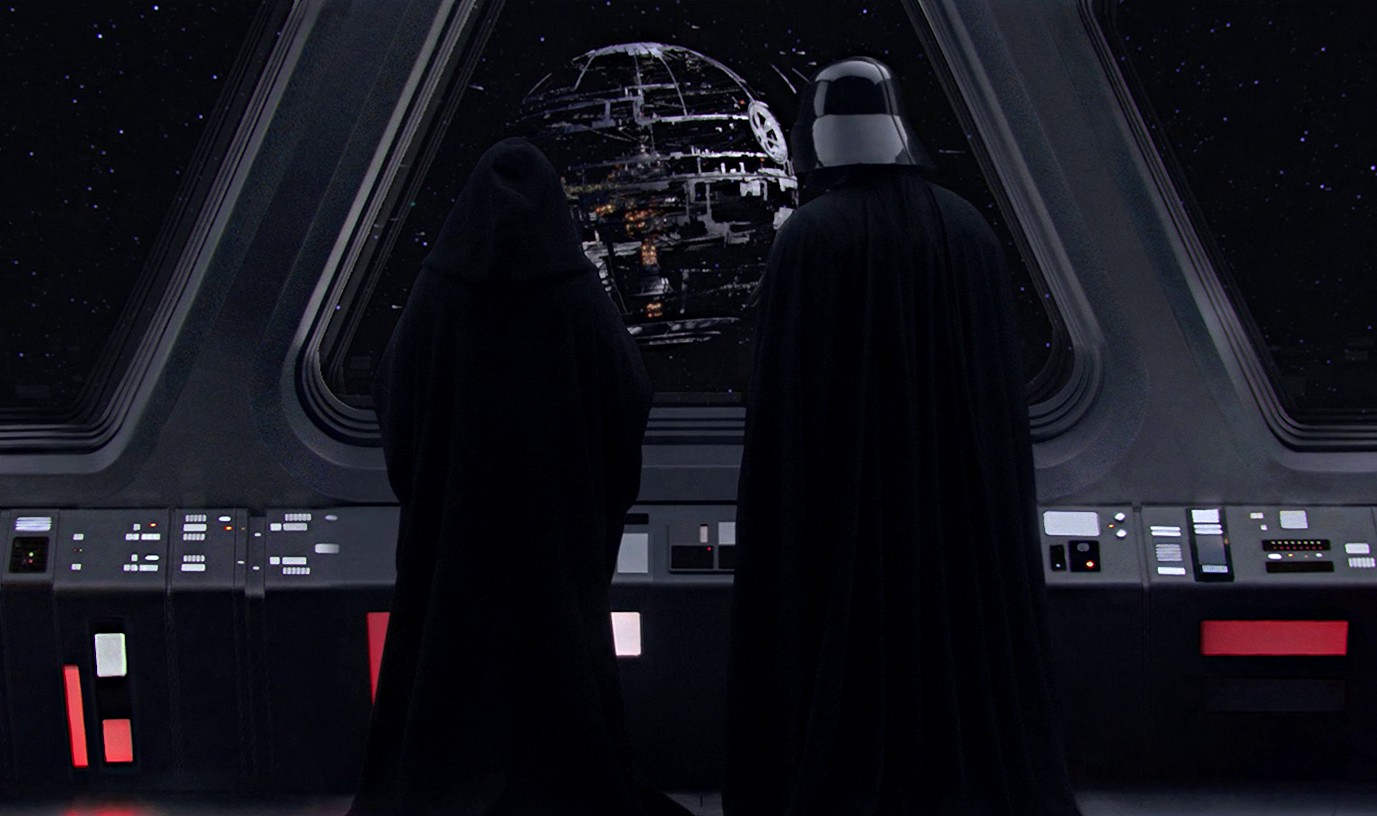
Emperor Palpatine and Darth Vader witness the construction of the first Death Star.
Following the deaths of all the members of the Separatist Council, and the end of the Clone Wars in 19 BBY, a majority of the Separatist holdings were turned over to the newly established Galactic Empire, including the unfinished battlestation. Construction was renewed under Imperial supervision and moved to Despayre in order to secure Palpatine's newly formed absolute power. Wilhuff Tarkin was appointed to mastermind the secret development project. Tarkin's creative work and thought had resulted in the realization of the Death Star as the Empire's ultimate weapon.
To help build the superweapon and curry the Emperor's favor, Tarkin had Darth Vader lead an Imperial invasion of Kashyyyk, where they enslaved Wookiees for labor. These Wookiees were transported to the Death Star's construction site. Much of the needed funding came from appropriated funds originally earmarked for the Department of System Exploration and the Department of Public Works.
However, despite these early advances in labor and funding, the project nearly ended before it began. Although much of the technology of the Death Star was impressive, actually building it proved to be more difficult than anyone imagined. The project dragged out over nineteen years as labor union disputes along with the supply and design problems slowed the construction. Efforts were not helped by repeated—albeit usually unsuccessful—sabotage efforts. In addition, Lemelisk had to undergo Bacta treatment after being Force-choked by Darth Vader, requiring a temporary replacement to oversee the development. Actual effective work on the station took less than two years, and involved resources from every corner of the Empire being funneled to complete the project.
Of particular concern was the technology required to create the massive superlaser, the heart of the weapon. To this end, Tarkin brought together some of the most brilliant minds of the galaxy (including Tol Sivron, Qwi Xux, and Bevel Lemelisk) to build a proof-of-concept model at Maw Installation. This model would eventually become known as the Death Star prototype.
Besides the concave dish model of the battle station's superlaser, other superweapon systems proposed during its development included a Resonance Torpedo Launcher system, an Interplanetary Ion Cannon, and a regular Composite Beam Superlaser model.
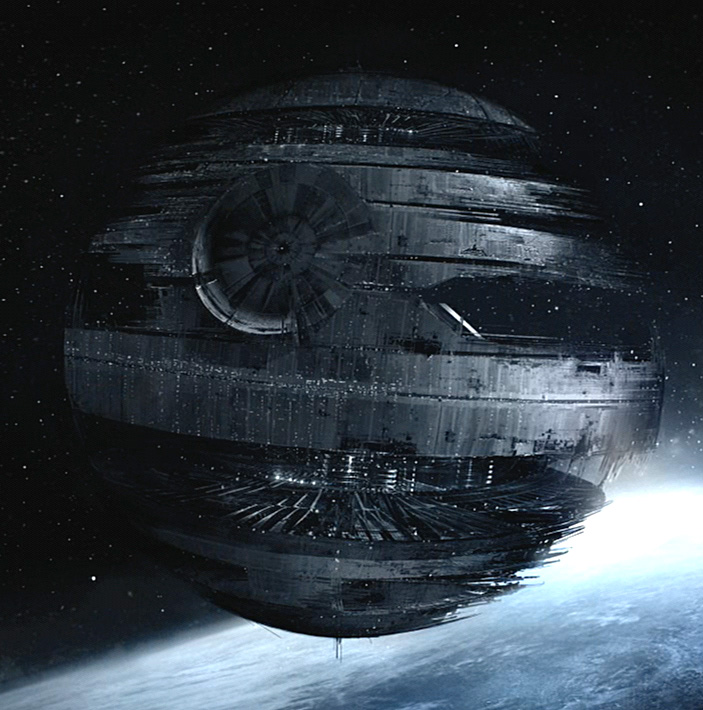
The Death Star under construction
It is uncertain exactly when the term "Death Star" came into use in connection with the project. The earliest known reference to the name Death Star as a codename for the project was in a memorandum c. 5 BBY written by Imperial advisor Ars Dangor, which formally placed Wilhuff Tarkin in overall command of the project. Once the Imperial Ministry of Propaganda began using the name Death Star, the name stuck.
Even before the Death Star became fully operational, its detention blocks began to fill with detainees. Political troublemakers, Rebel insurgents (who were beginning to organize), dangerous pirate forces, and even some survivors of the Royal Naboo Security Forces who had boldly tried to stop their Queen's assassination, as well as myriad other enemies of the Empire, were made to quietly "disappear" from public view within the enormous prisons of the incomplete battle station.
In the year 2 BBY, four individuals who would later become leaders of the Rebel Alliance were transferred to the Death Star: the Senators Bail Organa, Garm Bel Iblis, and Mon Mothma, along with a former Jedi General named Rahm Kota. Palpatine had the four sent to the battle station following their capture on Corellia, planning to have them interrogated and tortured, followed by public execution. This plan was foiled by the former apprentice of Darth Vader, Galen Marek. Galen arrived and attempted to rescue the rebels, and in the end apparently sacrificed himself so the four leaders could escape. Further, albeit limited, information about the Death Star's development was intercepted by the Bothan Spynet and made its way to the Rebel Alliance via low-security communiqués, something that Lemelisk had anticipated.
At some point afterwards, the Death Star's reconstruction was reassigned to Geonosis. During this time, it was also heavily guarded by the Imperials. A StarSpeeder 1000 that had escaped from an Imperial raid at the Star Tours space station and was delivering a Rebel agent to the Rebel Fleet ended up being attacked by Darth Vader's fighter squadrons as well as the Mandalorian bounty hunter Boba Fett. This eventually culminated in a fight in the inner workings of the Death Star, which suffered minor damage. In addition, the Death Star superlaser's completion was delayed after a Rebel attack on the Imperial facility of Desolation Station resulted in the theft of the Tributary beam component as well as the total destruction of Desolation Station.
The stormtroopers of the 501st Legion were among those assigned to protect the Death Star's interior. They were forced to put down a prison break that had somehow occurred within the station, led by a Jedi Padawan inmate. A number of prisoners were able to obtain a partial technical readout of the battlestation, which was beamed to a Rebel cell on Polis Massa. Shortly after this embarrassing debacle, the 501st were reassigned and moved off the station.
Because of the controversial nature of its weaponry, Imperial officers were required by their field manual to refer to the Death Star concept in general or the DS-1 as the official title of Imperial Planetary Ore Extractor to any non-Imperial news outlets, as well as to report the questioner to the Imperial Security Bureau for a thorough follow-up as a precaution.
In 0 BBY the station was attacked by a rebel force consisting of the Lucrehulk-class battleship Fortressa and 500 X-wings. The battle ended with the fleet being destroyed, and the Fortessa being struck by the Death Star's superlaser.
The history regarding the acquisition of the plans by the Rebel Alliance is a complex and convoluted one. Although three separate sets of schematics were stolen, only combined could they provide a thorough analysis of the space station's weaknesses.
In 0 BBY, Princess Leia Organa of Alderaan, perhaps while the Alliance Intelligence investigated the existence of a superweapon, was informed about it by a soldier she rescued on Ralltiir. The existence was justified by Intelligence on AX-235. Rianna Saren's report on the Destruction of Despayre confirmed the power of the battlestation's superlaser.
In addition, Rahm Kota issued a reconnaissance mission to the station to gather intel on its primary systems, in particular its superlaser weapon. X2 personally volunteered for the mission, feeling indebted to trying to stop the Empire he unwittingly aided in creating. At this time, the tributary beam had just been shipped to the Death Star, which X2 discovered via a transmission from X1 intended for the commander of the Death Star. X2, under Kota's command, then made an impromptu superlaser test on an Imperial-class Star Destroyer that the Rebels had hijacked and scuttled earlier, causing them to realize the unimaginable destructive power behind the weapon.
Around the same time, Rebel leader Garm Bel Iblis, with help from professional thief Moranda Savich, acquired a series of heavily encrypted datacards from an Imperial defector on Darkknell. It was only after sending these to the Alliance that the resistance discovered the exact purpose of Governor Tarkin's "pet project": to inspire fear through the destruction of worlds.
Following the Death Star Uprising, the aforementioned set of partial schematics was beamed to the Rebel base on Polis Massa. While it wasn't long before the Fighting 501st executed a swift raid on the compound, Bothan spies managed to transmit this first set off-base, presumably to their other asteroid base, AX-235. With one piece of the puzzle secure, the Alliance scrambled to secure more sets of plans, sets which would complete the picture.

Gun batteries attempt to defend against Rebel starfighters.
It was at this time that a rumored Alliance cell on Kalakar Six had acquired the plans, and Palpatine and Vader investigated the matter personally. In the end, the effort was deemed a wild bantha chase, as the planet was devoid of any Rebel sympathizers at all; in truth, the mission was most likely a ruse orchestrated by the Emperor to test his pupil's worth.
Meanwhile, real efforts to secure the Death Star plans were underway. Rebel agent Kyle Katarn, a former Imperial Academy graduate, had used his combination of stealth and brute force to wrest a supplemental set of plans from the Empire during the Battle of Danuta. With two smaller examples of the schematics, the Rebels set about acquiring the last, largest set of plans.
Through the actions of operative Bria Tharen and Red Hand Squadron, the Alliance engaged the enemy on the planet Toprawa. Operation Skyhook, as it was called, resulted in one of the biggest victories to date for the Rebels: the final set of plans would at last be in their control.
On Toprawa, operative Havet Storm transmitted the plans, as well as the plans for the superlaser, to Tantive IV, a consular ship in orbit. With these two additional bits in tow, the starship fled the system and intercepted the readouts from Katarn and AX-235, with Princess Leia herself spearheading the entire operation. By taking advantage of her diplomatic immunity, Leia hoped to seek out her father's friend, Obi-Wan Kenobi, and from there extrapolate a plan to analyze the schematics for a weakness in the superweapon's defenses.
But fate would take a different turn.

Grand Moff Tarkin reviews the battle plan on the command deck of the Death Star.
When Darth Vader and the 501st led a raid aboard Tantive IV, no plans were to be found. At the last moment, Leia, realizing the importance of the plans' survival, placed them inside astromech droid R2-D2 who, alongside C-3PO, made their way down to the surface of Tatooine with the goal of delivering the plans for safekeeping to Obi-Wan. After being captured by scavenging Jawas and then sold to moisture farmer Owen Lars, the astro-droid knew he was getting close to finding Kenobi. Accompanied by Owen's step-nephew, Luke Skywalker, R2 found who he was looking for.
After being captured by Lord Vader, Princess Leia was charged with espionage and treason and taken to the Death Star for interrogation, Vader's obsessive quest for the Rebellion's hidden base of operations being his primary focus. When she proved to be substantially resistant to Vader's methods of torture, Governor Tarkin ordered her to be brought to his command center. Tarkin threatened Leia with the destruction of her homeworld, Alderaan, and Leia deliberately misled him, saying that the Rebel base was on the remote planet of Dantooine. However, Tarkin, wanting a higher-profile target for his demonstration, ordered the Destruction of Alderaan while Leia watched helplessly. Billions were killed; the overall effect of the operation was to spread the message of fear the Empire needed to keep all planetary systems under control.
Luke, Obi-Wan, Han Solo, Chewbacca, C-3PO, and R2-D2, aboard the Millennium Falcon, were captured in a tractor beam after coming out of hyperspace near the remains of Alderaan and drawn onto the Death Star. They hid in several secret compartments in the ship while stormtroopers searched it, and then headed up to the control room. Obi-Wan devised a plan to free the ship by turning off a tractor beam projector.
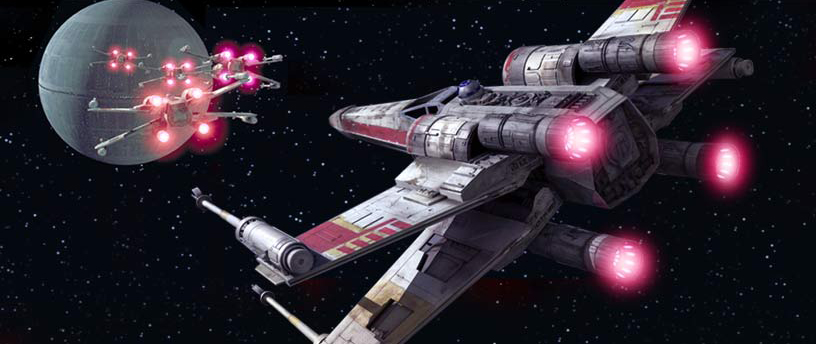
Rebel X-wings commence their attack run on the Death Star
After learning that the Princess was on board, Luke, Chewie, and Han headed to her cell block. They managed to free her despite being attacked by stormtroopers. They fled by jumping into a garbage chute, and despite being nearly crushed as the walls compacted, escaped after R2 shut them down. Heading back to the Falcon, they spotted a company of stormtroopers. The troopers were distracted by the battle between Obi-Wan and Darth Vader, allowing them to make it to the ship and take off, headed for Yavin IV.
There, R2-D2 uploaded the data tapes, and Alliance tactician Jan Dodonna found a weakness in the station: an unshielded thermal exhaust port that, if fired upon with a proton torpedo, would set off a chain reaction and annihilate the battlestation.
The ensuing Battle of Yavin destroyed the Death Star, just as it was positioned to destroy the newly discovered Rebel Base on Yavin's fourth moon. The Death Star was destroyed by Luke Skywalker in the trench run, who, with the help of the Force, successfully fired two proton torpedoes into the exhaust shaft that led directly into the Death Star's main reactor. Yavin 4 would have been destroyed by the Death Star seconds earlier had it not been for the hesitations of Master Chief Gunnery Officer Tenn Graneet, who delayed the firing because of his regrets for destroying Alderaan even though he was loyal to the Empire. He told his crew to "Stand by," unknowingly buying the Rebel Alliance the time to successfully destroy the battlestation. Ironically, shortly before Luke Skywalker fired the proton torpedoes into the thermal exhaust port, Palpatine had ordered the creation of a second Death Star.
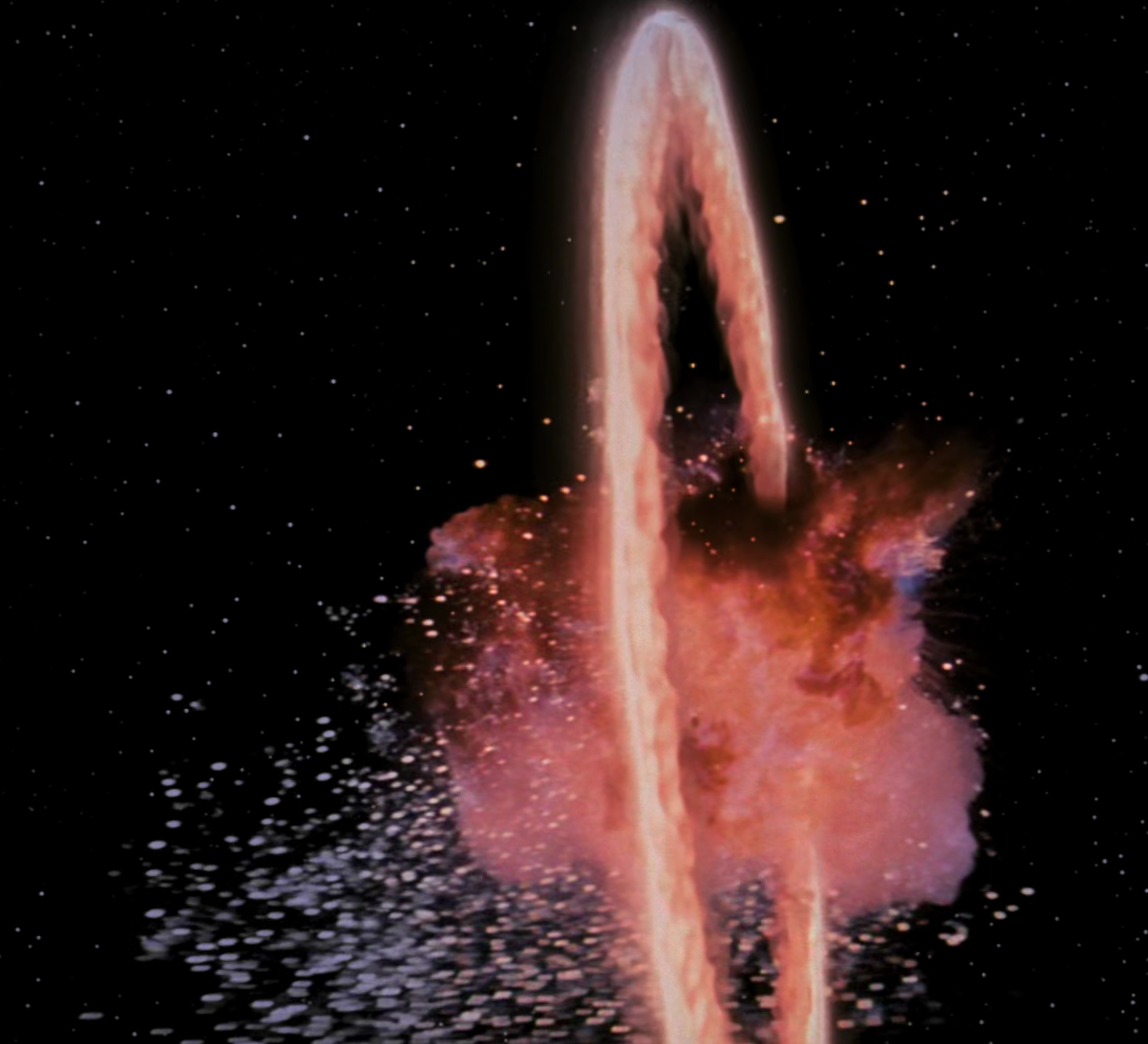
The Death Star is destroyed at Yavin
The reactor exploded, destroying the battlestation and killing everyone still on board, including Grand Moff Tarkin. It would prove a decisive moment for the Rebellion, and gave young Skywalker his first spot in galactic history. Even though the Empire remained the most prominent military power in the galaxy, this major Alliance victory gained credibility and support for their movement. In the months following the battle, thousands of star systems joined the Alliance, leading to the escalation of the Galactic Civil War.
Although the destruction of the Death Star was primarily an Alliance victory, it also acted as a blessing in disguise for the Empire, in particular the Imperial Navy. Because its development diverted untold amounts of credits and talent from the Navy, other development projects, including those directly related to the creation of a new class of Star Dreadnoughts that would act as a new pinnacle of capital-ship power, experienced a lot of delays. The Death Star's destruction gave the project in question a newfound importance to the Empire.
In addition, extensive data had been beamed to a communications complex on Galvoni III, which included a lot of transmissions, images, and footage of events up to the last seconds of the Death Star's existence, including the rescue of Organa and other related events. The Rebel Alliance–aligned historian Voren Na'al infiltrated the complex and stole much of this data, narrowly escaping and eventually publishing a report on the superweapon.
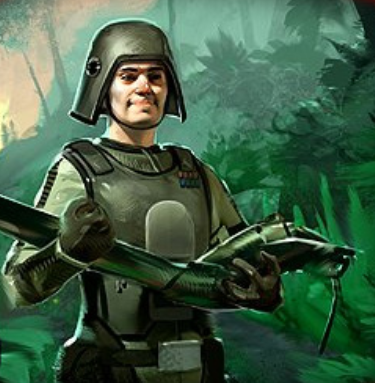
An Imperial officer brings a piece of debris from the Death Star for analysis.
Soon after the destruction of the giant battle station, salvaging companies and other organizations such as the Ugors and the Ni'lyahin Smugglers arrived at Yavin IV and carted off large chunks of debris. It didn't take long before the Empire stepped in and stopped all further theft by unauthorized agencies.
The Empire set up an Imperial Salvage Station in orbit around Yavin IV to collect the floating remains of the destroyed Death Star. The salvage team aboard the station was led by Major Reskik of the Imperial Security Bureau. The salvage teams consisted of civilian engineers sent by the major defense contractors that had provided the primary system designs for the Death Star project. Additional zero-G work crews were provided by the Empire.
Countless pieces of debris rained down on the jungle moon. Many left scorched craters behind and set the jungles on fire. Some pieces remained largely intact. After the Alliance left Yavin 4, many salvage teams combed the jungles to recover pieces of Death Star technology. Many independent salvagers like Nagem Dr'Lar sold the debris to the Empire. But other organizations interested in the Empire's technology also sent their own teams to the remote moon. The Hutt Expeditionary Force led by Osae Meilea tried to recover debris for the Hutt crimelords. Even the Black Sun crime cartel tried to get their hands on pieces of the destroyed station.
A year after the Death Star's destruction, some spacers had a piece of wreckage from the battlestation.
Tyber Zann, Crime Lord of the Zann Consortium, was interested in some of the Death Star's debris since it contained information about the Aggressor-class Star Destroyer and the Eclipse-class Super Star Destroyer.
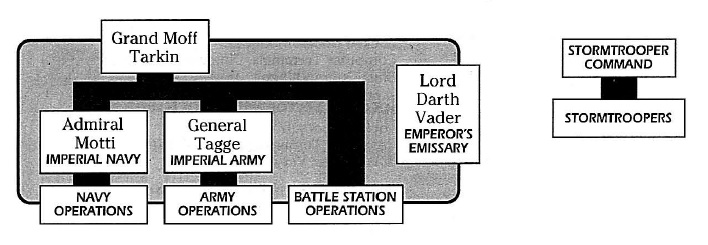
Death Star command organization
Like any organization within the Galactic Empire, the command structure within the Death Star was very strict. Command sectors were found throughout the Death Star, and were supervised by Imperial officers with a rank of lieutenant or higher.
Excluding visitations from the Emperor, the battlestation fell under the direct command of a triumvirate headed by Grand Moff Tarkin, Admiral Conan Antonio Motti of the Imperial Navy, and High General Cassio Tagge of the Imperial Army. The Chiefs of Navy, Army, and Battle Station Operations were held by officers with the rank of Colonel, or, in the case of Trech Molock, High General. Below each Operations Chief were eight majors who served as chiefs of specific departments under heir branch of operations. Four majors were also responsible for the general, service, technical, security, and military sectors, the last of which included Army troopers, gunners, pilots, and specialized versions of the Navy Troopers known as the Death Star Troopers. Members of the Imperial Security Bureau (ISB) were also stationed on board.
There were also two significant portions of the Death Star's complement that did not fall under the normal command structure yet were notable. The first was the Emperor's emissary, Darth Vader, who answered to Tarkin and otherwise was not subject to any other authority aboard the battle station. The second were the Stormtrooper Corps. While the Stormtroopers could work alongside the Army and Navy troopers as well as the ISB personnel if their services were required, they did not fall under their jurisdiction and thus were hardly subservient to either branch, as their primary loyalty was to Emperor Palpatine alone. They also worked to ensure that all officers complied with the policies of the Emperor's New Order.
At any given time, around 1.7 million Imperial personnel (excluding droids) were aboard the battlestation.
The security sector was the sector of the Death Star charged with patrolling and guarding vital or off-limits areas aboard the Death Star. The members of the security sector were the Imperial security officers, otherwise known throughout the Empire as wardens. Their duties included, besides patrols and guarding vital or off-limit areas, the maintenance of detention cell blocks, policing corridors, and protecting visiting officials. The wardens were likewise among the only Imperial officers aboard the battle station to carry personal weapons at all times. The wardens were assigned to several different security divisions, including enforcement, protection, surveillance, and detention, the last three working together to create a complete umbrella of security aboard the battlestation. The surveillance stations remained on alert throughout all duty shifts, relying on a myriad of hidden cameras, sensors, mobile remotes, and droids. However, the wardens themselves were under constant surveillance and observation, due to each standard security sector being required to provide office space and reasonable assistance to the ISB. The ISB and the security forces maintained a tense relationship, largely because the ISB was well known for placing undercover agents among military and technical-support personnel as well as their policing and surveillance techniques being even harsher than regular Imperial security standards. They also maintained their own armory on each sector.
Members of the security sectors were also charged with putting down disturbances (such as an out-of-control argument between crew members) and restoring order, as the Death Star was comparable to a community by Tarkin, himself a former commander of the Republic Outland Regions Security Force.
The Service and Technical Sectors were tasked with maintaining the Death Star. Technicians were assigned to these two sectors. The Service Sector was tasked with inspecting, maintaining, repairing, and replacing machinery. The jobs varied from highly skilled technicians trained to build components from scratch, to droids programmed to clean corridors. In addition, members of the Service Sector were required, as their most important duty, to keep up the station's protective and emergency gear. They were also required to maintain a variety of gear, from TIE Fighter pilot gear to Viper Probe Droids. RA-7 protocol droids worked throughout the station, including in the maintenance sections, which earned them the nickname of "Death Star Droids," despite technically being outnumbered by the MSE-6 droids. When not assigned to performing repairs or routine maintenance of the machinery aboard the station, the members of the Service Sector were stationed at monitoring posts to check temperature and performance readings or waited for system-failure alarms to sound from diagnostics systems built in to the Death Star's machinery. They also were assigned to clean carbon buildup, change components, and overhaul engines at shops. Technical Sector technicians—those not selected for the Service Sector—worked in the science stations, medical bays, research laboratories, programming facilities, and engineering stations, with the possibility of developing a weapon even more destructive than the superlaser. Members of this sector, however, were constantly reminded that while they were important due to their service to the Empire, specifically to the Death Star, they were not more important than the military sector. The staff assigned to the medical stations of this sector possessed varying ranks and abilities, although their droids specialized in various medical techniques, including surgery, anesthesia, and prosthetics.
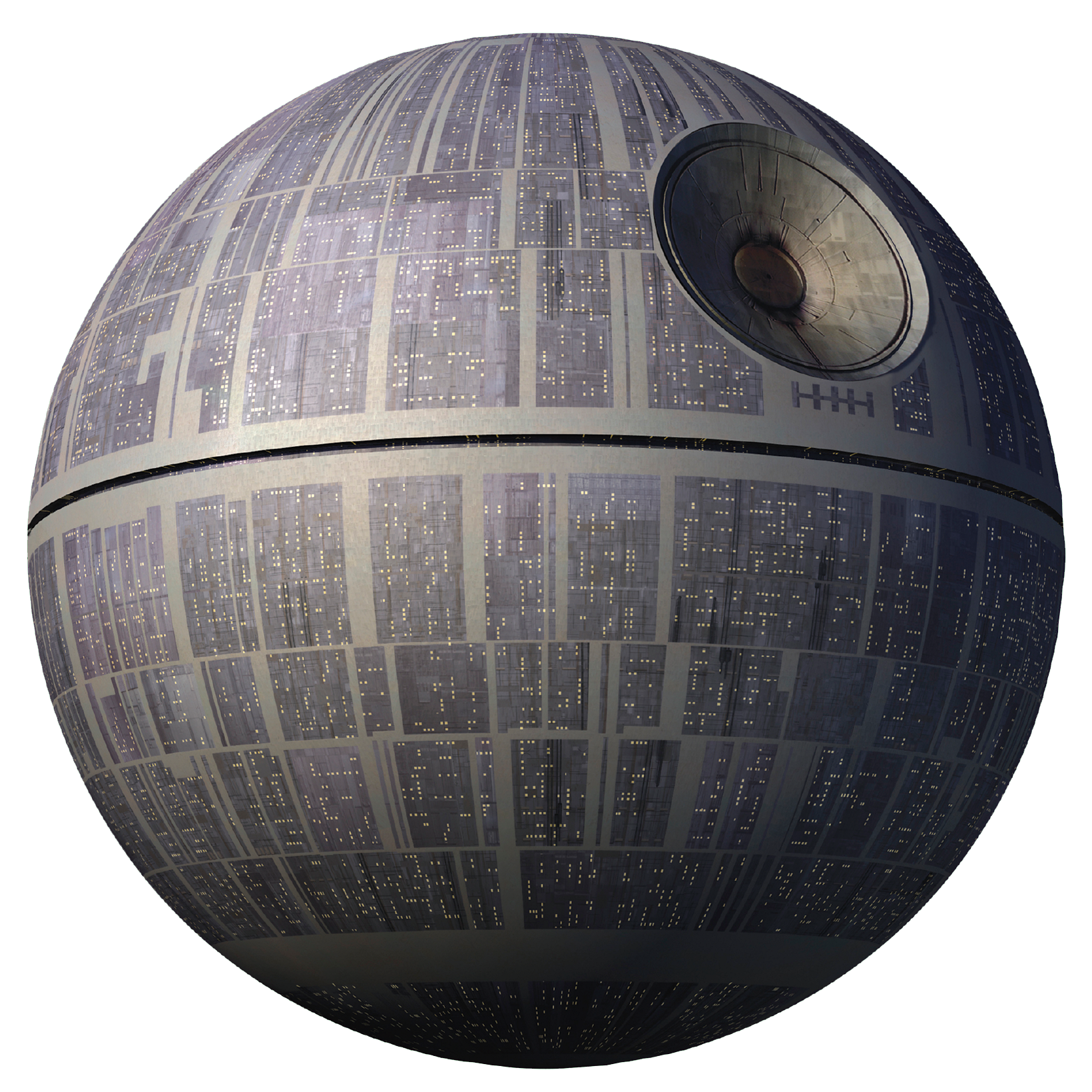
The first Death Star
The West End Games roleplaying game claimed that the first Death Star had a diameter of 120 kilometers.
The fact book Star Wars: Incredible Cross-Sections and detailed scaling of the station in the film suggested that the Death Star actually was 160 kilometers in diameter. However, according to statements by Grant McCune, Chief Model Maker for the movie, the scale used for the Death Star in the film was 1:180,000. The Death Star model was 120 centimeters in diameter which indicates that the Death Star was intended to be 216 kilometers in diameter. The fact book Death Star Owner's Technical Manual revised the diameter of the Death Star to 120 km. Leland Chee clarified on Twitter that this was an "un-retcon" that was based on evidence presented by the writers. However, as more recent sources such as The Essential Guide to Warfare and The Complete Star Wars Encyclopedia provided a length of 160 km, this article takes the 160 km length to be accurate.
In the early production of the original movie, the hollow dish was designed to be on the equator, but then the prop designers moved it to the "northern" hemisphere. However, the old design can still be seen in the grid plan animations in the movie. This is because the animation was created before the prop designers made the change, therefore leaving a blooper. The explanation that the plans represent an earlier version is invalid, since the original plan in Attack of the Clones shows the "later" form. Despite the fact that Attack of the Clones shows the plans in the "northern" hemisphere, The Essential Guide to Warfare states that the superlaser was originally on the equatior before being moved to the northern hemisphere.
In the Revenge of the Sith DVD commentary, Lucas made a comment that the Death Star seen at the end was the first Death Star. He explained this was due to "union disputes and supply problems." (Intriguingly, the lead characters in Kevin Smith's film Clerks speculate at some length about whether the Imperial workers were unionized or subcontractors. This may or may not be an in-joke by Lucas.) However, earlier Expanded Universe works, including Jedi Search and Champions of the Force, implied that what is seen in Revenge of the Sith is a prototype to the Death Star in A New Hope. This was retconned in The New Essential Chronology, which states that the latter was a testbed prototype for the superlaser to be installed on the former, and that the Death Star shown at the end of Revenge of the Sith is in fact the first Death Star.
A eponymous full-length novel, written by Michael Reaves and Steve Perry, was released in October 2007, and completely explains the events in and around the Death Star, during its construction, deployment, and eventual destruction. In Death Star it is stated that a zone was one twenty fourth of a hemisphere, but other sources instead say there was twenty four zones total. This article assumes Death Star is in error for this point
In many video games, particularly the Rogue Squadron trilogy, the player has to avoid many obstacles and make several turns when flying in the Death Star's trench run. The schematics/layout of the Death Star show no objects or turns in the trench, and the appearance of the trench in video games is deemed non-canon. For the first game, Star Wars: Rogue Squadron, released in 1998, the Battle of Yavin is a bonus mission, unlocked by achieving all gold medals in the campaign or via cheat codes. The Battle of Yavin in the sequel, Star Wars: Rogue Squadron II: Rogue Leader, is the game's first campaign mission and thus part of the game's canon storyline. Additionally, the Death Star serves as a location for multiple Versus Modes in Star Wars: Rogue Squadron III: Rebel Strike.
1993's Star Wars: Rebel Assault put players in the role of Rookie One, who destroys the Death Star in place of Luke Skywalker. This article follows the sequence of events shown in Star Wars: Episode IV A New Hope.
In the 2002 LucasArts video game expansion Star Wars: Galactic Battlegrounds: Clone Campaigns the Death Star can be summoned for players by typing the code "that's no moon" in the game's chatbox. The superweapon has the most powerful attack in the game, but it is slow to recharge.
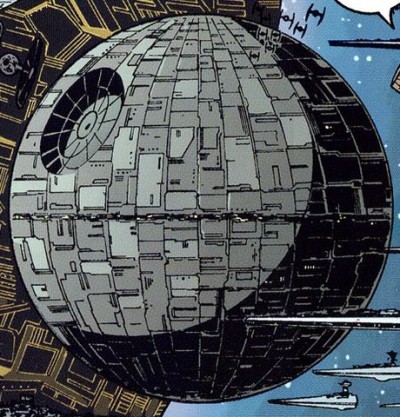
The Justice Star
In the non-canon comic Star Wars Infinities: A New Hope, the attack on the battlestation fails, and the Empire manages to drive away the Rebel forces. Five years later, the Death Star is renamed the "Justice Star" to mark the fifth anniversary of the Rebels' defeat and becomes a mobile seat of government for the newly restored Imperial Senate.
The Justice Star traveled from one system to the next, effectively replacing Coruscant as the center of the Empire. In an impressive display of symbolism, the Justice Star was stationed in front of Coruscant's sun, to eclipse it and thus be seen as a shining symbol of a new source of light for the galaxy.
This symbol was short-lived, however, as Yoda and R2-D2 commandeered the Justice Star, and used it to attack the Imperial Fleet, also manipulating Wilhuff Tarkin (by that point an Admiral) into doing so via a Jedi mind trick. Once the fleet was destroyed, they sent the battle station crashing into Coruscant's surface, killing Emperor Palpatine and destroying the massive superweapon.
- The first Death Star was represented by Kenner Products in the 1970s as a series of playsets (including the Devastator, of which there is a unique model with red box) to be joined to build the space station.
- The LEGO Group produced two different sets (10188 in 2008 and 9676 in 2012). The first was the station divided into many rooms and no outer shell, each room a scene from A New Hope or Return of the Jedi; the second was a small model separable into two pieces, with inside the bricks to build a TIE/IN interceptor in miniature.
- LEGO Star Wars: The Complete Saga
- LEGO Star Wars: Microfighters video game
- Tag & Bink: Revenge of the Clone Menace
- "A Death Star Is Born" — Star Wars Tales 4
- "Prey" — Star Wars Tales 11
- † Tag & Bink Are Dead
- LEGO Star Wars II: The Original Trilogy
- † Star Wars Infinities: A New Hope
- Choose Your Own Star Wars Adventure: A New Hope
- "The Long, Bad Day" — Star Wars Tales 16
- The Return of Tag & Bink: Special Edition
- "Tall Tales" — Star Wars Tales 19
- "Free Memory" — Star Wars Tales 10
- Club Penguin Star Wars Takeover
- Star Wars: Tiny Death Star
- "Perfect Evil"
- Death Star Designer
- LEGO Star Wars: The Dark Side